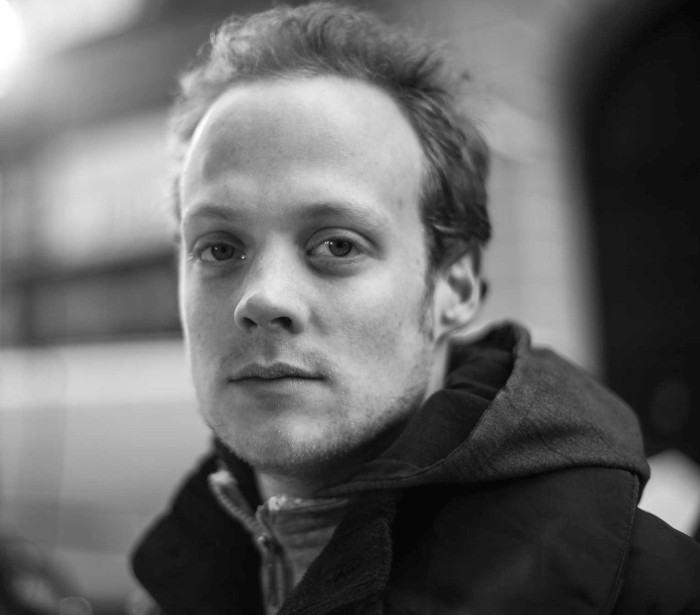
What color do you see for Monday?
Imagine that one day you wake up and all the words have disappeared. You cannot order a café in the buffet, you cannot praise your college’s dress and you cannot argue in debates anymore. But life goes on: if you want to survive, you must develop your new language which is expressed through colors, sounds, lights. This question and the phenomenon of synesthesia were the starting points for Péter Fancsikai’s installation, called Synesthesia, which debuts on the Night of Theatres and part of smART! XTRA series.
You started as an actor but after a while, you developed interest in media design. What brought about change? How do these fields relate to each other?
I’ve been working on a lot of different things, but all were connected to movies and theatre, to media design. These fields cannot be separated. The priority changes, but visuality has always been in my focus. Media design came close on MOME, but I’ve never had an installation like Synesthesia before.
By the way I still participate in foreign and Hungarian movies sometimes but my newest passion is music making.
Why did you start the Synesthesia project?
Everything started with Gondolat Generator groups’s ‘Without words’ competition that made me wonder about the topic: how could we live without words? Could we communicate only through colors and sounds? I wanted to examine it in an interactive situational environment.
Synesthesia is such an interesting phenomenon: several people experience its different versions. Some attach colors with weekdays, others associate to numbers. Obviously this all has a canonized, institutionalized part – even if it’s unconscious – for example when we pair ‘black’ and ‘mourning’.
What type of synesthesia works in your head?
It changes, but for example I attach colors to weekdays. Tuesday is white, Sunday is red – the color usage of calendars might be responsible for the latter. These commonly used symbols might overwrite our inner thoughts. The installation is looking for an answer to this exact question: what is canonized? Does pink mean sensuality for every human? The machine consists of several part: first, the synesthesia phenomenon itself, than the 6 basic emotions, which were determined by an American psychologist in the 20th century. The emotional categories are the basis for the visual and melodic loops I created – the participants can activate and couple them.
So can we say that your installation is an experiment as well?
Yes, it obviously has an experimental or scientific side; however we won’t examine our participants. But the installation can give a sensual and intellectual experience for the user.
How does it work?
The machine is based on visual projection and melodies, which are activated by the participant. The keyboard is signed with different colors. This half-scientific-half-metaphoric approach is originated from Newton: during his light-experiment he paired letters to colors. Light and sound both have a frequency in their own mathematical zone. These can be identical – eg. C sound transposed up to 40 octave (which cannot be heard by humans) gives the same frequency as a certain shade of green. From this view, there is a scientific explanation for synesthesia. Obviously, it doesn’t mean that humans with synesthesia feel the same color-sound connections.
When you play the piano, you experience harmony or dissonance – depending on the match of the color and sound. I also added a tape to the installation, which represents the physical form of sounds. The old walkman’s tape is placed in front of the participants. The melodies, which can be heard on the installation are written by me on a computer. These are half electrical – half-classical musical phrases. From this view, this installation is my own synesthesia. That’s how music, sound and visuality cohabits in my head.
Due to your works, you communicate through speech, sounds, lights, colors. Which is the most effective communicational form to you?
In my everyday life the most comfortable is verbalism. Speech lets me express myself on a more differentiated way. Nevertheless, there is a point, where words are not enough or there is no exact word for the feeling you want to reflect. Sometimes the music I write expresses an unconscious feeling I wouldn’t had been able to verbalize. If you can use it correctly, speech is edited, fast, controlled and comfortable.
What do you personally feel when you play the piano?
My perspective is different from the participants’. The artistic attitude dominates and I am always analyzing the machine. I am modifying it until the day of the premiere. During the working process, I had intellectual and sensual experiences, so it is different for me than for someone who sees it for the first time. I can keep a bigger distance from the songs I’ve written. If I hear them in movies or in the theatre, I am only a spectator there. However, the installation is an interactive game, which makes me think about the working process.
Where can we try the installation after the premiere?
Probably on Harmadik Ember festival, in November. Ambient and noise concerts take place in Három Holló and Synesthesia will be installed in RS9’s gallery.
Dalma Takács

















